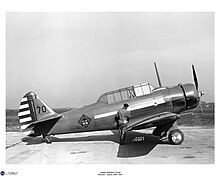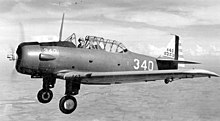North American BT-9
| North American BT-9 | |
|---|---|
 47th School Squadron's BT-9 at Randolph Field |
|
| Type: | Trainer aircraft |
| Manufacturer: | |
| First flight: |
April 1936 |
| Number of pieces: |
557 (517 USAAC / 40 USN) |
The North American BT-9 was a two-seat trainer aircraft manufactured by North American Aviation in the 1930s.
history
US Army Air Corps and US Army Air Forces
The starting point for the development was the experimental monoplane training aircraft North American NA-16 from 1935, from which a whole family of military aircraft was derived. The NA-16 had lost in 1935 in the competition for a basic trainer against the Seversky BT-8 . North American then improved the NA-16 to the NA-18 with a closed cockpit and landing gear fairing and offered it to the USAAC for renewed assessment. After the BT-8 did not particularly prove itself in training use, the USAAC placed the order in early 1936 to build 42 aircraft with performance requirements modified compared to the first tender.
The first machine flew in April 1936 under the designation BT-9. The BT-9 kept the R-975 radial engine of the NA-18, but differed in a higher cockpit glazing, a controllable pitch propeller and an additional roll cage. At the end of the 1930s, the USAAC's training units increased significantly and North American received further orders in 1937 to build 40 armed BT-9A for airborne rifle training. The armament consisted of a 7.62 mm machine gun with a camera and a swiveling machine gun of the same caliber in the stern. The 117 BT-9B, which were delivered in 1937 and 1938, corresponded to the unarmed BT-9, but had a reinforced central wing section. The BT-9C was a weapons trainer based on the BT-9B, 67 of which were assigned to the reserve units in 1938. In 1939 a BT-9B, which had been equipped with the outer wing parts and the rudder of the BC-1A developed in parallel from 1937, was tested as the BT-9D. The machine probably served as a prototype for the subsequent BT-14.
After the Air Corps Expansion Plan adopted in 1940, North American received another contract to build 251 BT-14s, an improved variant of the BT-9. Deliveries were completed in 1941. The BT-14 had some all-metal components of the BC-1A / AT-6 , so their fuselage, wing assemblies and the tail unit were used. The 450 hp R-985-25 radial engine was used as the engine. Of the 251 machines, 27 were given an R-985-11 engine with only 400 hp, which was then referred to as the BT-14A.
At the end of 1936, North American received an order from the Bureau of Aeronautics of the US Navy to build 40 NJ-1s, which differed from the BT-9 by the installation of a more powerful R-1340 engine with 500 hp. " N " stood for trainer aircraft and the letter "J" for the manufacturer. The first 39 machines of the construction lot were the NAS Pensacola allocated during the last copy tentatively with a 12-cylinder - V-engine Ranger V-770 -4 was equipped.
Use in the French and Canadian Air Forces
The French Armée de l'Air ordered variants with the batch numbers NA-57 (corresponded to BT-9B) and NA-64 in 1939 and 1940. The NA-64 was a further development of the NA-57 and received some improvements from the BT-14. A total of 230 NA-57s (30 of them for the Aéronavale) and 111 NA-64s were delivered to the Armée de l'Air up to the armistice. The French Air Force gave the NA-64 the designation NAA 64.P2, with the addition P2 indicating that it is a two-seat advanced training aircraft ( perfectionnement biplace ). 230 copies of the NA-64 had also been ordered, but after France surrendered, Canada received the remaining 119, where they were listed as North American Yale I.
Used by the Wehrmacht Air Force
After the surrender-like armistice of June 22, 1940, the Luftwaffe confiscated the 8 NA-57 and 93 NA-64s that were found, which were transferred to Luftwaffe flight schools until mid-1941. During the invasion of the previously unoccupied zone in southern France on November 11, 1942 , another 50 NA-57s were captured. In total, the Air Force flew over 200 former French training aircraft. These were mainly used by the Luftwaffe at the fighter pilot schools and Stuka preschools, less at other weapon schools or for beginners' training. On January 31, 1944, 44 NA-57s and 43 NA-64s were still in the Luftwaffe's inventory. It can be assumed that some of the aircraft became spare parts donors in order to keep the stock airworthy. In 1944, the aircraft were among the most frequently flown types - based on flight hours per aircraft - in the Air Force.
variants
- BT-9
- (Batch number NA-19) 400 HP engine R-975-7, 42 built
- BT-9A
- (NA-19A), like BT-9, but with two 0.3-in-MG (bow and back of the fuselage) and a shooting camera, 40 built
- BT-9B
- (NA-23), minor changes to BT-9, 117 built
- BT-9C
- (NA-29), like BT-9B, equipped for use with Organized Reserve Units , 67 built
- BT-9D
- (NA-26), single BT-9B fitted with the airframe of the North American BC-1 A.
- NJ-1
- (NA-28), US Navy version of the BT-9, 500 hp engine R-1340-6, 40 built, one was temporarily converted with an XV-770-4 as the NJ-2
- BT-10
- a BT-9C was fitted with a 600 hp R-1340-41 engine in 1938, the initial designation was Y1BT-10
- BT-14
- (NA-58), further development of the BT-9B with wings of greater depth, angular wing ends, redesigned rudder surfaces, metal-clad fuselage, 450-hp engine R-985-25, 251 built
- BT-14A
- 27 BT-14 retrofitted with a 400 HP R-985-11 engine
Technical specifications
| Parameter | Data |
|---|---|
| crew | 2 |
| length | 8.54 m |
| span | 12.81 m |
| Empty mass | 1504 kg |
| Max. Takeoff weight | 2029 kg |
| drive | 1 × 9-cylinder radial engine Wright R-975 -7 with 400 HP NJ-1: 1 × 9-cylinder radial engine Pratt & Whitney R-1340 with 500 HP |
| Cruising speed | 275 km / h |
| Marching speed | 235 km / h |
| Summit height | 6000 m |
| Range | 1400 km |
| Armament (BT-9A / C) | one fixed and one movable 7.62 mm MG |
| price | $ 20,000 |
Incidents
In total, there were at least 80 accidents with this type of aircraft.
literature
- ER Johnson: American Military Training Aircraft - Fixed and Rotary-Wing Trainers since 1916. McFarland and Co., 2015, ISBN 978-0-7864-7094-5 , pp. 86-89.
- Susan Harris Encyclopedia of Aircraft Technology, Models, Data. Weltbild Verlag GmbH, Augsburg 1994, p. 254, ISBN 3-89350-055-3 .
- John M. Andrade: US Military Aircraft Designations and Serials since 1909. Midland Counties Publ., 1979, ISBN 978-0-904597-21-9 , pp. 60 f.
Web links
Individual evidence
- ^ Dan Hagedorn: North American's T-6 - A definitive history of the world's most famous trainer. Specialty Press, 2009, p. 70 f.
- ^ Federal Archives-Military Archives Freiburg: Production programs 1940/1941; Lists of French aircraft seized in November 1942; RL 2III Lists of losses from schools and other associations; Flight operations statistics from January to September 1944
- ↑ ER Johnson, 2015, p. 88
- ↑ Accidents with the North American BT-9 , Aviation Safety Network , accessed December 27, 2018



